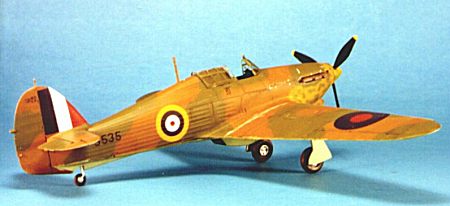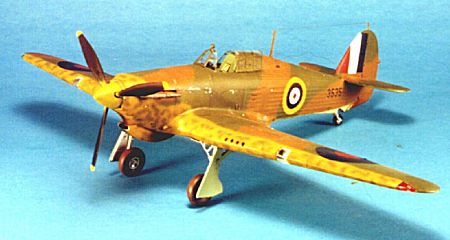
|
KIT: |
Hasegawa 1/48 Hurricane I trop |
|
KIT # |
09323 |
|
PRICE: |
$29.98 |
|
DECALS: |
See Review |
|
REVIEW & |
|
|
NOTES: |
Aftermarket decals: Aeromaster 48-195/440 |
Editors Note: this is the first of three installments from Tom Cleaver on the building of three Hasegawa 1/48 Hurricanes. This first review covers the history and generic construction comments. The other two installments will go into specifics concerning the other types modeled.

The Airplane:
Eclipsed by publicity during the Battle of Britain by its more graceful-looking stablemate, the Spitfire, the Hawker Hurricane has always lived in the elliptical-winged shadow of Reginald Mitchell's revolutionary masterpiece. Rather than a stroke of genius, the Hurricane was evolutionary in its heritage, standing as it did atop the body of work of its designer, Sir Sidney Camm, who had and would design many of the most famous and successful aircraft used by the Royal Air Force for another thirty years after the Hurricane's appearance. The Hurricane was the first modern fighter to enter RAF service, and later the first modern fighter to be used by the Fleet Air Arm.
 In fact, the Hurricane won the Battle of Britain, supported by the Spitfire.
Three-fifths of the RAF squadrons committed to the struggle flew into battle in
Hurricanes, and the overwhelming majority of claims were credited to Hurricane
pilots. If Churchill was right that "never in the field of human conflict
was so much owed by so many to so few," the truth is that never did the few
owe so much to one airplane. While the Hurricane was largely replaced in the
front ranks of Fighter Command within a year of its victory - though it would
serve another two years in the fighter-bomber role over Northwestern Europe -
the airplane was in the thick of battles over Malta, the Western Desert, and
Southeast Asia for the rest of the war; in service with the Fleet Air Arm, it
would be involved in epic air battles defending Malta convoys in the
Mediterranean, and flying off escort carriers to attack U-boats in the North
Atlantic and on the Murmansk run. The Hurricane would remain in first-line
service throughout the Second World War, one of only seven aircraft in service
with any air force on September 3, 1939 about which that could be said.
In fact, the Hurricane won the Battle of Britain, supported by the Spitfire.
Three-fifths of the RAF squadrons committed to the struggle flew into battle in
Hurricanes, and the overwhelming majority of claims were credited to Hurricane
pilots. If Churchill was right that "never in the field of human conflict
was so much owed by so many to so few," the truth is that never did the few
owe so much to one airplane. While the Hurricane was largely replaced in the
front ranks of Fighter Command within a year of its victory - though it would
serve another two years in the fighter-bomber role over Northwestern Europe -
the airplane was in the thick of battles over Malta, the Western Desert, and
Southeast Asia for the rest of the war; in service with the Fleet Air Arm, it
would be involved in epic air battles defending Malta convoys in the
Mediterranean, and flying off escort carriers to attack U-boats in the North
Atlantic and on the Murmansk run. The Hurricane would remain in first-line
service throughout the Second World War, one of only seven aircraft in service
with any air force on September 3, 1939 about which that could be said.
The Hurricane Kits:
It was not until Hasegawa released their Hurricane Mk.IIc in 1997 that the airplane was really catered to in a satisfactory manner by a major kit manufacturer. Criticism has been made by some that the fabric effect on the rear fuselage is overdone, but overall this kit is light years ahead of the competition; as a major for-intance, it is the only model of the Hurricane to get the wing dihedral right. With the release of the latest kits in the series, a modeler can now do the Mk.I, Mk.I Tropical, Mk.IIb, Mk.IIc, Mk.IId and the Sea Hurricane Mk.IIc "out of the box" with Hasegawa kits.
Aftermarket resin sets from CMK provide the long-range tanks used on
Hurricane night intruders and SEAC fighter-bombers, as well as separate control
surfaces; there is also a resin cockpit set, but to this modeler it is
superfluous as the kit cockpit is more than acceptably detailed. The one real
failing of the Hasegawa kit, the one-piece canopy, is solved by use of the
Squadron vac-form canopy, which can be mounted in the open position to give a
more realistic look.
acceptably detailed. The one real
failing of the Hasegawa kit, the one-piece canopy, is solved by use of the
Squadron vac-form canopy, which can be mounted in the open position to give a
more realistic look.
Aftermarket decal sheets abound for every mark of Hurricane as used by nearly every air force that ever flew the airplane, with those by Aeromaster among the very best.
So far as research material is concerned, any modeler who has in his library the Squadron-Signal "Hurricane In Action" and Richard Franks' "The Hawker Hurricane: A Comprehensive Guide for the Modeler," has everything needed to make any version of Hurricane desired.
Overall Construction Notes:
Hasegawa is noted for excellent engineering of their kits, and the Hurricanes are no exception. The one problem of the kit is that when the lower wing assembly was designed, it cut straight across through the underfuselage fabric effect, rather than along a panel line; this means a modeler must putty the area and sand off carefully. I find that the fact there is exhaust staining seen on the lower rear fuselage in nearly every Hurricane photo provides the chance to hide this with weathering at the end of construction.
Additionally, the kit is designed to have the canopy closed. When using the Squadron canopy, a modeler needs to build up the area that would be under the canopy aft of the headrest, to get rid of the noticeable ridge. Checking photos in either of the references noted above makes this easy. Beyond this, if a modeler follows the kit instructions for the variant being created, the result will be an excellent model.
Hurricane I (Tropical), 3 Squadron RAAF, Egypt, late 1940:
 The Hurricane might have been outclassed by the late-model Bf-109Es and
certainly by the early Bf-109Fs that were appearing by the end of the Battle of
Britain, but it was a godsend to the RAF and Commonwealth units in the Middle
East, which had been using Gloster Gladiator and Gauntlet biplanes against the
Italian CR-42s. The Macchi C.200 monoplane - far superior to its British
competition - had just arrived on the scene; fortunately, the Hurricane was
easily superior to this Italian fighter, even when equipped with the
drag-inducing tropical filter.
The Hurricane might have been outclassed by the late-model Bf-109Es and
certainly by the early Bf-109Fs that were appearing by the end of the Battle of
Britain, but it was a godsend to the RAF and Commonwealth units in the Middle
East, which had been using Gloster Gladiator and Gauntlet biplanes against the
Italian CR-42s. The Macchi C.200 monoplane - far superior to its British
competition - had just arrived on the scene; fortunately, the Hurricane was
easily superior to this Italian fighter, even when equipped with the
drag-inducing tropical filter.
3 Squadron RAAF was one of the first units to receive the Hurricane, and was also the first to use the "Italian camouflage" ruse, in which the nose and leading edges of the wings of their Hurricanes were painted tan with dark green splotches to mimic Italian Air Force camouflage and thereby confuse Italian ground forces when they were engaged in ground attack, as well as perhaps give themselves the extra moment of confusion in aerial combat that can make the difference that leads to victory. The fact that the squadron did not at the outset use any identifying squadron codes, and took off the letter on the serial number, meant it would be easy to use the kit decals to create one of these airplanes.
Construction Notes:
When constructing the Hurricane I in either the standard or tropical version, it is important to note that the wing is meant to also be used on the Mk.IIb version, with the two extra machine guns in the outer wing. Be sure to sand off the gun bay doors that are molded proud on the upper wing surface. Past that, there are no construction problems.
Painting:
 I painted the airplane using Gunze-Sanyo H-72 "Dark Earth," H-73
"Dark Green," and Tamiya XF-21 "Sky." According to the
information in the Franks "Hurricane" book, the RAF did not adopt the
Dark Earth/Middle Stone/Azure Blue camouflage until 1942. RAF camouflage had a
"hard" edge, since masking matts were used. I use drafting tape, cut
to the pattern, with a piece of thread 1/16" in from the edge to lift it
and allow a bit of "scale overspray;" this also prevents paint
build-up that leaves a "ridge" when the tape is pulled up.
I painted the airplane using Gunze-Sanyo H-72 "Dark Earth," H-73
"Dark Green," and Tamiya XF-21 "Sky." According to the
information in the Franks "Hurricane" book, the RAF did not adopt the
Dark Earth/Middle Stone/Azure Blue camouflage until 1942. RAF camouflage had a
"hard" edge, since masking matts were used. I use drafting tape, cut
to the pattern, with a piece of thread 1/16" in from the edge to lift it
and allow a bit of "scale overspray;" this also prevents paint
build-up that leaves a "ridge" when the tape is pulled up.
The "Italian camouflage" was created by mixing some Dark Earth with Tamiya XF-4 "Flat Yellow," which is most likely the way the RAF created the color originally - though there is a thought they might have used "sand tan" also used on British tanks. This was sprayed freehand over the nose and the leading edge of the wing - on both the upper and lower leading surfaces - per a profile in the Franks book. I then mottled this with Dark Green. The result was a very distinctive camouflage pattern.
Final Finishing:
I "Futured" the model, and when dry, applied the decals. When these were dry, I used a thinned mixture of rubbing alcohol and Tamiya X-19 "Smoke" to shadow-shade certain areas and emphasize the fabric effect, as well as to create exhaust and gunfire stains on the fuselage and wings.
I then "Flat Futured" the model, using a mixture of Future and Tamiya "Flat Base". When this was done, I attached the Squadron canopy with white glue, and used nylon repair thread for the antenna wire.
Next, the Hurricane IIb